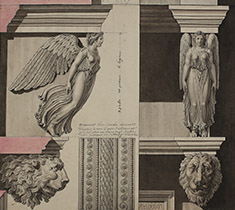26 Feb – 8 May 2016
http://www.wallraf.museum/
The remains of Palmyra have fascinated people for centuries. Tourists and scholars alike have visited Syria to admire a city whose culture bore the stamp of the Romans, Greeks and Persians – until the summer of 2015, that is, when the terrorist organisation Islamic State attacked it and destroyed the most important temples. At the time of writing, no end to the destruction is in sight. This appalling situation has prompted the Wallraf-Richartz-Museum to think about what survives. The exhibition Palmyra: What’s Left? presents more than thirty drawings by the French artist, archaeologist and architect Louis-François Cassas (1756–1827). In 1785, over a period of just two months, Cassas made detailed on-site drawings of virtually all the city’s remains. He captured the beauty and fascination of the ancient sites with a breathtaking immediacy that has lost none of its power to impress. The exhibition also offers an insight into the period in European history when archaeologists and scholars first discovered the desert city.
Travelling in the Middle East from 1784 to 1787, Cassas was one of the first architects and archaeologists to visit Palmyra and Baalbek. Seeking answers to key questions in architectural history, he focused on the aesthetic qualities of materials, the construction technology used in the buildings and the origins of certain forms and styles – issues that still occupy experts today.
http://www.wallraf.museum/
The remains of Palmyra have fascinated people for centuries. Tourists and scholars alike have visited Syria to admire a city whose culture bore the stamp of the Romans, Greeks and Persians – until the summer of 2015, that is, when the terrorist organisation Islamic State attacked it and destroyed the most important temples. At the time of writing, no end to the destruction is in sight. This appalling situation has prompted the Wallraf-Richartz-Museum to think about what survives. The exhibition Palmyra: What’s Left? presents more than thirty drawings by the French artist, archaeologist and architect Louis-François Cassas (1756–1827). In 1785, over a period of just two months, Cassas made detailed on-site drawings of virtually all the city’s remains. He captured the beauty and fascination of the ancient sites with a breathtaking immediacy that has lost none of its power to impress. The exhibition also offers an insight into the period in European history when archaeologists and scholars first discovered the desert city.
Travelling in the Middle East from 1784 to 1787, Cassas was one of the first architects and archaeologists to visit Palmyra and Baalbek. Seeking answers to key questions in architectural history, he focused on the aesthetic qualities of materials, the construction technology used in the buildings and the origins of certain forms and styles – issues that still occupy experts today.
